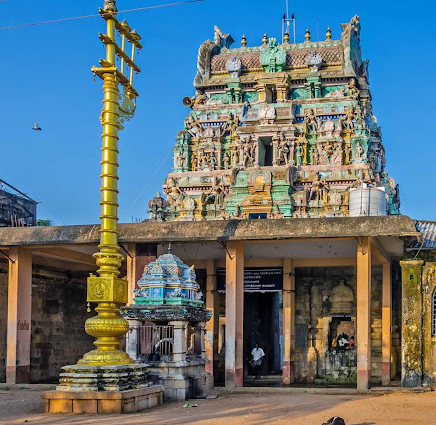Lord Brahma, once cursed by Lord Shiva, began to lose his gentle traits (Sattva Guna). To restore his virtues, Brahma undertook a pilgrimage to several Shiva sthalas. Pleased with his devotion, Lord Shiva granted Brahma darshan in his wedding form, accompanied by Mother Parvathi, Vinayaka, and Muruga. As a result, Lord Shiva is revered as Sarguna Nathar, the Lord of Gentle Traits. Brahma also created a sacred spring, Brahma Theertha, and initiated the Brahmotsavam festival, which takes place in the Tamil month of Vaikasi (May-June).
Sthala Puranam :
At one point, Lord Brahma began to lose his satvik gunas (pure traits and powers). To regain them, he came to earth and worshipped Lord Shiva at various places, including this one, which was then called Vilvaranyam. Here, Lord Shiva, along with Parvati, Vinayaka, and Muruga, appeared before Brahma and blessed him. Pleased, Brahma regained his lost virtues and created the large Brahma Teertham (temple tank) on the eastern side of the temple. Since Lord Shiva blessed Brahma with his satvik gunas, He is worshipped here as Sargurunathar.
Later, the demon Idumban bathed in the sacred tank and worshipped Lord Shiva here to rid himself of his sins. In return for his devotion, Shiva granted Idumban salvation, which led to the place being named Idumbavanam. It is believed that this Idumban is not the same as the devotee of Murugan but the demon Hidimba from the Mahabharata, who was killed by Bhima. Hidimba's sister, Hidimbaa, later married Bhima, and their son was Ghatotkacha. The legend suggests that Idumbavanam was one of the places the Pandavas passed through during their exile, and nearby Kunralur was the location of Idumban’s fort.
After the famous incident at Thirukadaiyur, where Lord Shiva saved Sage Markandeya, Yama, the God of Death, lost his powers. He came to this temple, worshipped Lord Shiva, and had his powers restored.
Since this temple is on the ancient route from Kodiakarai to Rameswaram, it is also believed to be one of the locations where Lord Rama worshipped Shiva during the Ramayana, before setting off for Lanka.
Sage Agastya visited this temple and relieved a Brahmin couple (Deva Sarma and his wife), who had been cursed and turned into demons. Through Agastya's guidance, they prayed at this temple and were relieved of their curse when he sprinkled holy water on them.
This temple is also one of the sites where Sage Agastya was blessed with a vision of the divine wedding of Lord Shiva and Parvati. To commemorate this event, a depiction of Shiva and Parvati in their kalyana kolam (wedding posture) is placed behind the main deity in the sanctum.
A devotee named Gunabaran brought his father’s ashes to immerse them in the temple's tank. Upon reaching the site, he saw an image of his father appearing before him and blessing him. For this reason, the temple is considered a special site for pitru puja (ancestral rites).
The Vellai Vinayakar (white Vinayaka) at this temple is believed to be made from sea foam.
When Saint Thirugnana Sambandar visited the temple during his pilgrimage from Vedaranyam to Madurai, he saw a Shivalinga in every grain of sand. To avoid stepping on these sacred lingams, he walked on his hands and head.
The temple is believed to be a Chola-period construction, estimated to be about 1100 years old, dating back to the reign of Raja Raja Chola I. It contains exquisite artworks, including paintings from the Nayak and Maratha periods and unique single-stone sculptures of Dakshinamurti, Gajalakshmi, and Sani. Inscriptions found in the temple detail grants made by the Maratha kings in support of the temple.
Administration History :
The administration of the temple has evolved over centuries, beginning with its establishment during the Chozha period. It underwent significant reconstruction and expansion under the Nayakas and Nattukottai Nagarathars. During the Maratha Kings' rule, various gifts and endowments were made to support the temple's upkeep. The temple continues to be managed by the Hindu Religious and Charitable Endowments Department of the Government of Tamil Nadu, ensuring its preservation and ongoing rituals.
